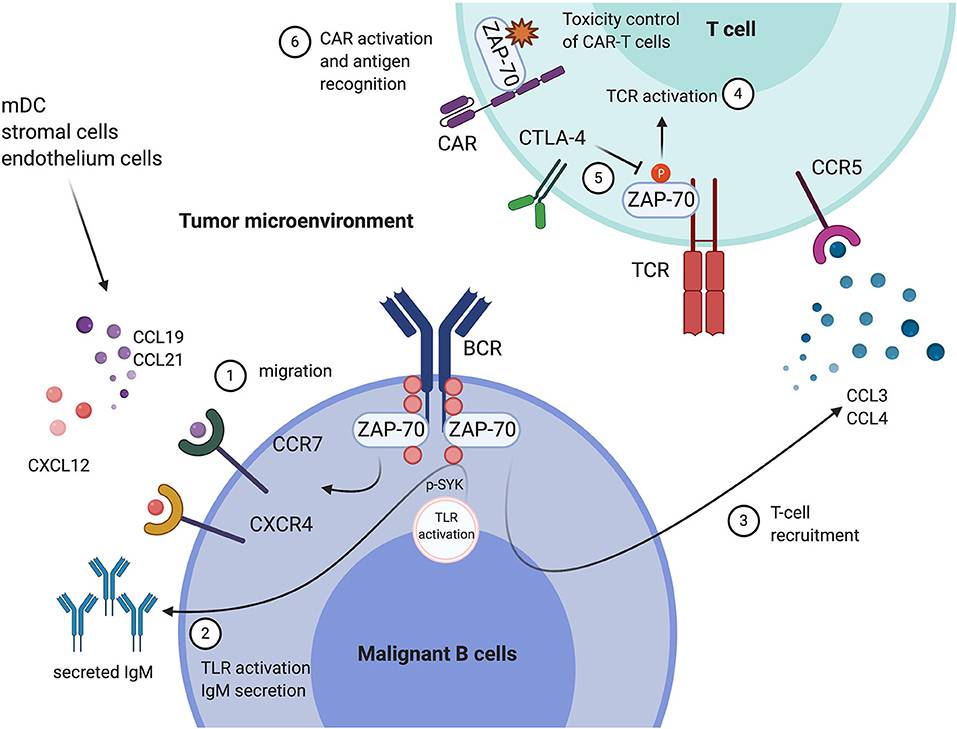What is ZAP70 Protein
The ZAP70 protein, officially known as "Zeta-chain-associated protein kinase 70," is a critical player in the immune system, belonging to the protein kinase family. It is also known by synonyms such as Syk-related tyrosine kinase, ZAP-70, and SRK.
ZAP70 Protein Structural Characteristics and Classification
ZAP70 is characterized by its unique structural characteristics, primarily consisting of two SH2 (Src homology 2) domains and a kinase domain. These domains enable ZAP70 to be intricately involved in signaling cascades following T-cell receptor (TCR) activation. This activation involves the phosphorylation of tyrosine residues and is essential for the initiation of downstream signaling pathways.
Recent Research Advances about ZAP70 Protein
Recent research has expanded our understanding of ZAP70's significance. One notable advance involves the discovery of ZAP70's role in autoimmune diseases and cancer. Scientists are uncovering how ZAP70's aberrant signaling contributes to these conditions, shedding light on potential therapeutic targets.
ZAP70 Biological Functions and Molecular Mechanisms
ZAP70 plays a pivotal role in the immune system, particularly in T-cell function. When TCRs on the surface of T-cells recognize antigens presented by antigen-presenting cells (APCs), ZAP70 is activated. This triggers a cascade of events, ultimately leading to T-cell activation.
The molecular mechanisms underlying ZAP70's function involve phosphorylation events. Upon TCR recognition, ZAP70 is recruited to the TCR complex and becomes phosphorylated itself. This activated ZAP70 then phosphorylates various downstream signaling proteins, leading to the activation of transcription factors like NFAT and NF-κB. These transcription factors play a critical role in regulating gene expression, ultimately promoting T-cell proliferation, cytokine production, and immune responses against pathogens.

Figure 1. Tumor ZAP-70 expression modulates the tumor- and immune microenvironment. (Chen J, et al., 2020)
ZAP70 Related Signal Pathway
The ZAP70-related signal pathway is primarily associated with T-cell receptor (TCR) signaling. When TCRs recognize antigens, they undergo conformational changes that facilitate the recruitment and activation of ZAP70. This activation triggers a phosphorylation cascade involving various downstream signaling molecules, including LAT, SLP-76, and PLC-γ1. Ultimately, these signaling events lead to the activation of transcription factors that drive T-cell responses.
ZAP70 Related Diseases
While ZAP70 is crucial for normal immune function, its dysregulation is associated with several diseases. One of the most well-known conditions linked to ZAP70 is severe combined immunodeficiency (SCID), a rare genetic disorder that impairs the immune system's ability to fight infections. In SCID, mutations in the ZAP70 gene can result in a non-functional or reduced-function ZAP70 protein, compromising T-cell development and function.
Additionally, ZAP70 has been implicated in autoimmune diseases such as rheumatoid arthritis and multiple sclerosis. In these conditions, ZAP70 signaling appears to be overactive, contributing to the immune system's attack on the body's own tissues.
Cancer is another area of interest in ZAP70 research. Some studies suggest that ZAP70 expression is associated with the aggressiveness of certain types of leukemia and lymphoma, making it a potential biomarker for disease prognosis.
ZAP70's Applications in Biomedical
The unique characteristics of ZAP70 make it an attractive target for biomedical applications. Its significance is evident in diagnostic development, vaccine development, and therapeutics.
- Diagnostic Development: ZAP70 serves as a valuable biomarker for several diseases, including SCID and certain cancers. In diagnostics, measuring ZAP70 levels or activity can help identify patients with these conditions, aiding in early diagnosis and prognosis.
- Vaccine Development: ZAP70's role in T-cell activation is crucial for immune responses. Researchers are exploring how ZAP70 can be harnessed in vaccine development to enhance the body's ability to recognize and fight specific pathogens. By understanding the molecular mechanisms, scientists can design more effective vaccines.
- Therapeutics: ZAP70 is a potential target for therapeutic intervention in diseases with aberrant immune responses, such as autoimmune diseases and certain cancers. Inhibiting ZAP70 activity or modulating its signaling pathways may offer new treatment options. Research is ongoing to develop drugs and therapies that target ZAP70 in these conditions.
Recommended Products
| Cat.# | Product name | Species | Source (Host) | Tag |
|---|---|---|---|---|
| ZAP70-3777H | Recombinant Human ZAP70, GST-tagged | E.coli | GST | Human |
| ZAP70-1511H | Active Recombinant Human ZAP70 Protein, GST-tagged | Insect cells | GST | Human |
| ZAP70-458H | Recombinant Human ZAP70, GST-tagged, Active | Sf9 Insect Cell | GST | Human |
| ZAP70-750H | Recombinant Human ZAP70, GST-His | Sf9 Insect Cell | GST | Human |
| ZAP70-1490H | Recombinant Human ZAP70 protein, His & T7-tagged | E.coli | His/T7 | Human |
| ZAP70-98H | Recombinant Human Zeta-chain (TCR) Associated Protein Kinase 70kDa | E.coli | N/A | Human |
| ZAP70-885HFL | Recombinant Full Length Human ZAP70 Protein, C-Flag-tagged | Mammalian cells | Flag | Human |
| ZAP70-9486HF | Active Recombinant Full Length Human ZAP70 Protein, GST-tagged | Insect (sf21) | GST | Human |
| ZAP70-2382H | Recombinant Human ZAP70 Protein, His (Fc)-Avi-tagged | HEK293 | His (Fc)-Avi | Human |
| ZAP70-18692M | Recombinant Mouse ZAP70 Protein | Mammalian Cell | His | Mouse |
Reference
- Chen J, et al. ZAP-70 shapes the immune microenvironment in B cell malignancies. Frontiers in Oncology. 2020, 10: 595832.

